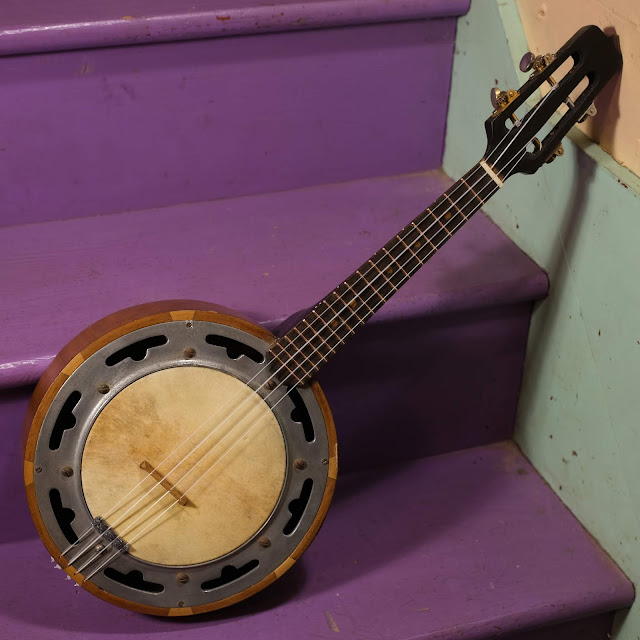1930s Italian-made Banjo Ukulele Conversion
While this same type of instrument was made in Italy, France, and Germany, I'm pretty sure this is of the Italian persuasion. Certain things suggest that -- like the fact that the neck, tuners, and tailpiece were originally fixed to the instrument with nails. How about that? I guess it worked for 80+ years, so who am I to judge...?
It started-off as a banjo-mandolin but I repaired some hairline splits in the headstock and the reduced the tuners to four, '60s-era all-metal tuners. I then converted the rest of the instrument to suit a nylon-strung, banjo-ukulele application. I think it's far more successful this was, as this design only sounds and works "so-so" as a banjo-mandolin because of the small head and light build, but as a banjo-uke it has a killer, breathy, focused, punchy sound.
Besides, it has copper frets! I think nylon/Nylgut/what-have-you will treat them a bit more kindly than steel.
Repairs included: hairline and chip-out repairs to the headstock along the path of the old mandolin tuners' mounting screws, a fret level/dress, cleaning, new hole-mount stringing at the "tailpiece" end so I could be rid of the original mandolin tailpiece, a new bone nut, side dots install, neck-bolt reinforcement at the heel, and a setup.
Setup notes: it plays bang-on with 1/16" action height at the 12th fret and it's strung with Aquila Nylgut strings. The neck is straight.
Scale length: 14 1/4"
Nut width: 1 1/8"
String spacing at nut: 15/16"
String spacing at bridge: 1 1/4"
Head diameter: 6 5/8"
Rim/resonator diameter: 10"
Rim/resonator diameter: 10"
Rim depth: 2 1/8"
Rim material: unsure, some sort of hardwood w/lining and maple veneer
Neck wood: maple or poplar
Fretboard: ebonized maple
Bridge: maple, 1920s US-made banjo-uke bridge
Neck feel: medium C-shape, flat board, narrow-ish nut width
Condition notes: replacement tuners, obviously, plus filled holes along the side of the headstock. There are exposed repair screws on the rear of the headstock (I kinda like that, but could hide them if desired), too. There's a medium amount of usewear throughout plus some chipped-off veneer on the side of the rim that you can see in some of the photos.
The rim design is the typical Euro-style "zither" banjo design, where the head is tensioned-up via top-mounted bolts and a bottom tension-hoop assembly against a flange that's also a tonering. This instrument is fairly lightweight and comfortable to hold and play. It's not much heavier than your average archtop mandolin from the time.
This originally had a zero fret but I removed it as it was installed in a funky manner. I replaced it with a normal, bone nut. The copper frets are bar stock.
Nice marquetry-style inlay on the back, huh?















Comments